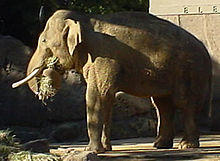| Elephas Temporal range: Pliocene to present | |
|---|---|
 | |
| Asian elephant | |
| Scientific classification | |
| Kingdom: | Animalia |
| Phylum: | Chordata |
| Class: | Mammalia |
| Order: | Proboscidea |
| Family: | Elephantidae |
| Tribe: | Elephantini |
| Genus: | Elephas Linnaeus, 1758 |
| Type species | |
| Elephas maximus Linnaeus, 1758 | |
| Species | |
| 8; see text | |
| Synonyms | |
| Hypselephas | |
Elephas is one of two surviving genera in the family of elephants, Elephantidae, with one surviving species, the Asian elephant, Elephas maximus.[1]
Several extinct species have been identified as belonging to the genus, including Elephas recki, straight-tusked elephant E. antiquus and the dwarf elephants E. falconeri and E. cypriotes. The genus is very closely related to the genus Mammuthus.[2]
Taxonomy
The scientific name Elephas was proposed by Carl Linnaeus in 1758 who described the genus and an elephant from Ceylon.[3] The genus is assigned to the proboscidean family Elephantidae and is made up of one living and seven extinct species:[4]
- Elephas maximus – Asian elephant[1]
- Elephas maximus indicus – Indian elephant
- Elephas maximus maximus – Sri Lankan elephant
- Elephas maximus sumatranus – Sumatran elephant
- Elephas maximus borneensis – Borneo elephant, proposed but not yet recognized as valid[5]
The following Asian elephants were proposed as extinct subspecies, but are now considered synonymous with the Indian elephant:[1]
- Elephas maximus sondaicus Javan elephant †
- Elephas maximus rubridens – Chinese elephant †
- Elephas maximus asurus – Syrian elephant †
The following Elephas species are extinct:
- Elephas beyeri – described from fossil remains found in 1911 in Luzon, the Philippines by von Königswald[6]
- Elephas celebensis – Sulawesi dwarf elephant, described from southern Sulawesi by Hooijer in 1949[7]
- Elephas ekorensis – described from the Kubi Algi Formation, Turkana, Kenya[4]
- Elephas hysudricus – described from fossil remains found in the Siwalik hills by Falconer and Cautley, 1845[8]
- Elephas hysudrindicus – a fossil elephant of the Pleistocene of Java and different from Elephas maximus sondaicus[9]
- Elephas iolensis
- Elephas platycephalus
References
- ^ a b c Shoshani, J. (2005). "Genus Elephas". In Wilson, D.E.; Reeder, D.M (eds.). Mammal Species of the World: A Taxonomic and Geographic Reference (3rd ed.). Johns Hopkins University Press. p. 90. ISBN 978-0-8018-8221-0. OCLC 62265494.
- ^ Fleischer, R. C.; Perry, E. A.; Muralidharan, K.; Stevens, E. E. & Wemmer, C. M. (2001). "Phylogeography of the Asian Elephant (Elephas maximus) based on mitochondrial DNA" (PDF). Evolution. 55 (9): 1882–1892. doi:10.1111/j.0014-3820.2001.tb00837.x. Archived from the original (PDF) on 2012-03-17.
- ^ Linnaei, C. (1760). "Elephas maximus". Caroli Linnæi Systema naturæ per regna tria naturæ, secundum classes, ordines, genera, species, cum characteribus, differentiis, synonymis, locis. Tomus I. Halae Magdeburgicae: Ioannes Ioachimus Langius. p. 33.
- ^ a b Maglio, V.J. (1973). "Origin and evolution of the Elephantidae". Transactions of the American Philosophical Society, Philadelphia Volume 63. American Philosophical Society, Philadelphia, pp. 149
- ^ Fernando, P., Vidya, T.N.C., Payne, J., Stuewe, M., Davison, G., et al. (2003). DNA Analysis Indicates That Asian Elephants Are Native to Borneo and Are Therefore a High Priority for Conservation. PLoS Biol 1 (#1): e6
- ^ Von Königswald, G.H.R. (1956). Fossil mammals from the Philippines. National Research Council of the Philippines, Manila
- ^ Hooijer, D.A. (1949). Pleistocene Vertebrates from Celebes. IV. - Archidiskodon celebensis nov spec.. Zoologische Mededelingen Museum Leiden, 30 (#14): 205–226.
- ^ Falconer, H. & Cautley, P. T. (1846). Fauna Antiqua Sivalensis, Being the Fossil Zoology of the Sewalik Hills. Smith, Elder & Company, London, pp. 64.
- ^ Hooijer, D. A. (1955). Fossil Proboscidea from the Malay Archipelago and the Punjab. Zoologische Verhandelingen, 28 (#1): 1–146.